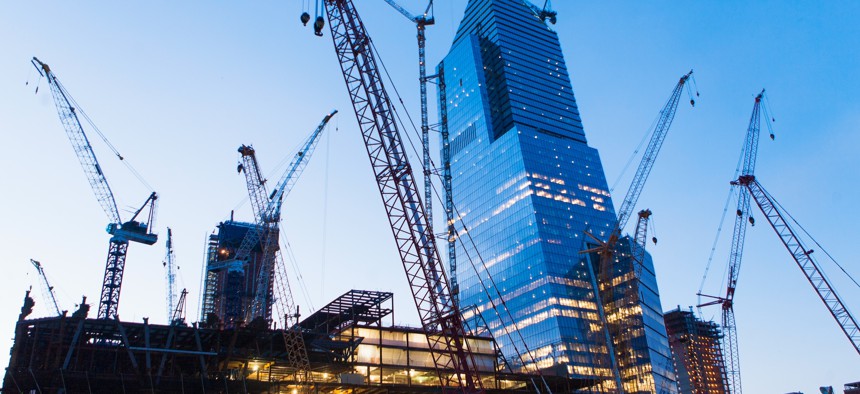New York City, with its status as the global city of finance, culture, and innovation, has long been synonymous with construction industry growth. Its skyline is constantly changing, historic structures are being preserved, and a wide range of infrastructure projects are underway – a testament to the city’s ability to continue growing and reaching. For hundreds of years, the sectors of construction, masonry, and renovation have played roles in the formation of the city. However, the industry has experienced a drastic change over the years. Starting from the elementary masonry structures in the past to the current cutting-edge, high-tech construction practices, the industry has constantly developed to meet the demands of New York’s unique environment and urban challenges.
In the following article, we discuss many of the steps forward that have shaped New York’s overall construction, masonry works, and renovation industries. We look at innovative technology, new trends, and the constant demand for sustainability and greater efficiency within a city ever expanding, changing, and reinventing itself.
New York’s Construction Industry: A Historical Perspective
New York’s construction roots date back to the very beginning of the city’s development. Buildings in the colonial period were very basic, and most were made of wood, stone, and brick, the latter two being mainly local materials. With the introduction of bricklaying, brickwork became the superordinate mode of construction in the 18th and 19th centuries, largely due to materials availability, fire resistance, and durability. It was the first major phase of the city’s construction development. The city’s monumental progress in architecture took root as a result of those major projects: the iconic brownstones and the monumental bridges, which include the majestic Brooklyn Bridge.
By the late 19th and early 20th centuries, steel-frame construction was born, which would go on to forever change the landscape of New York’s skyline. With the development of skyscrapers, masonry techniques were integrated into the architectural designs, often in decorative facades, while the skeleton of the building relied on steel and reinforced concrete. As a result, masonry works became more specialized, and New York’s general construction industry began to diversify into various sectors, including residential, commercial, and industrial construction.
The Evolution of Masonry Works
Masonry has been an important element of construction in New York for centuries. From simple brickwork to intricate stone facades, masonry is accountable for some of the most iconic structures in the city, including the Flatiron Building and the Rockefeller Center. Although steel and concrete have bypassed masonry as the structural skeleton of modern skyscrapers, where there’s preservation of the human touch, durability, and timeless beauty of masonry, then masonry is and will remain in demand both in new construction and renovations.
The art of masonry in New York has changed with time, integrated with new techniques, tools, and materials. Brick and stone masonry, the classical types, find a revival in domestic and urban renovation works. In addition to these, precast concrete, glass block, and lightweight masonry systems have found their place in the market. Modern materials provide greater energy efficiency, durability, and flexibility while still catering to the aesthetically pleasing and long-lasting quality of traditional masonry.
Techniques are concerned: Masons in New York now apply the most advanced technologies, in the use of laser scanning and 3D modeling, to assist them in getting precision and quality in their work. Such a technology allows for greater accuracy in measurements and planning, thus reducing errors and improving the overall craftsmanship. Also, the inclusion of sustainable materials such as reclaimed stone, bricks, and eco-friendly mortars finds its pedestal as the main aspect of New York’s green building movement.
General Construction: Paving the Way for Innovation
While masonry has long been a stalwart of New York’s construction, general construction also boasts a great amount of progress in terms of technology, materials, and construction techniques. The city’s need for taller buildings, more complex designs, and bigger commercial spaces resulted in innovations in terms of materials, technology, and types of construction methods applied.
Among the greatest developments seen in general construction is the wide use of Building Information Modeling. BIM is a digital modeling process through which construction teams can develop high detail 3D representations of buildings before construction starts. The technological tool enables better planning, collaboration, and visualization of the project, reducing the costs, errors, and delays associated with construction. Additionally, it allows teams to simulate building performance to ensure that a structure will meet energy efficiency standards, withstand extreme weather conditions, or comply with safety regulations. Another familiarity in general building construction is the use of pre-fabricated components. Pre-fabrication refers to the process of producing parts of a building, like walls, floors, and roofs, in a factory setting before they are transported to the construction site. This has resulted in saving labor costs, speeding up project timelines, and improving the quality control of building materials. New York particularly witnessed increases in the use of prefabricated housing and modular construction, especially in affordable housing as well as renovations for homes.
New York construction has also benefited from advanced construction equipment. Machinery is now more powerful, efficient, and safety-oriented, thereby augmenting productivity and reducing construction time. Cranes, excavators, and other heavy equipment now make use of the most sophisticated hydraulic systems, and computer control, to accomplish greater precision in material handling and structural assembly.
Renovation and Adaptive Reuse: On the Rise in New York
As the city continues its course of evolution, renovation and adaptive reuse projects became a big deal in New York’s construction landscape. So many old buildings exist within the city, and much of what has been preserved is considered architectural treasures. However, there is great demand for modern amenities and functionality in most buildings, thus bringing about numerous renovation projects aimed at breathing new life into these older structures.
Besides conserving the architectural history of New York, renovations also respond to the ever-mounting demand for sustainability. Older buildings usually require major updates to meet modern building codes, energy efficiency standards, and environmental regulations. Retrofitting an older building with updated mechanical systems, electrical wiring, and energy-efficient features is one of the greatest challenges-thus highly motivational-to construction techniques.
New York has emerged as the capital of adaptive reuse, where the older buildings were reused for new functions. A good example of this trend is when industrial warehouses that were previously used for storing different commodities are converted into loft apartments or offices. The process not only saves the city from losing its architectural history but also helps in reducing urban sprawl, saving valuable land for other purposes.
In recent years, the use of renovated technological work has extended to include robotics, with applications in demolition, material handling, and construction. Similarly, drones have been valuable assets in surveying buildings, inspecting roofs, and performing other hard-to-reach work on buildings. Thus, innovations change the renovation process in themselves, making renovation safer for workers.
Sustainable Construction: New York’s Future
Actually, sustainability is becoming an underlying theme under which the construction industry has to work from day to day in New York, and there was an emergent emphasis on environmental impact reduction of building projects. Green building initiatives, such as the requirement for LEED (Leadership in Energy and Environmental Design) certification, made considerable inroads, driving construction companies toward adopting more environmentally friendly materials and practices.
In masonry, sustainable techniques include green concrete and use of industrial waste materials to reduce carbon emissions; energy-efficient window systems and insulation are also gaining popularity. New York general contractors have also introduced green roofs, solar panels, and rainwater harvesting systems in their construction and renovation projects, all contributing to reduced energy consumption and environmental impact.
Challenges and Opportunities Ahead
Nevertheless, those advancements notwithstanding, the New York construction industry is still replete with challenges the spectrum that ranges from labor to skyrocketing material costs and servicing of an urban environment. Its dense population and unavoidable cramped space mean that construction projects often encounter difficult access, complex zoning laws, as well as maintaining the aesthetic of the city while embracing modern technology.
However, the new challenges offer new scope in growth and innovation. Construction in New York will continue to set the pace for developing new advanced technologies, sustainable building practices, and adaptive reuse strategies. In this urban landscape of the world, as the city grows and changes, so will the construction, masonry, and renovation styles shape the future cityscape.
Conclusion
The construction, masonry, and renovation industries in New York City have come a long way since the city’s early days of timber and stone buildings.
Today, the industry is defined by cutting-edge technologies, sustainable practices, and a renewed focus on preserving the city’s historic architectural legacy. From BIM and prefab construction to new masonry materials, and from adaptive re-use projects, New York is being transformed. The future of construction in New York will be even more interesting because the city is constantly evolving and rewriting its skyline.

